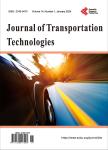Pedestrian Facilities Capacity and Level of Service at Intersections in a Connected and Autonomous Vehicle Environment
Pedestrian Facilities Capacity and Level of Service at Intersections in a Connected and Autonomous Vehicle Environment作者机构:Department of Civil & Environmental Engineering University of Delaware Newark USA College of Engineering University of Delaware Newark USA.
出 版 物:《Journal of Transportation Technologies》 (交通科技期刊(英文))
年 卷 期:2019年第9卷第4期
页 面:423-438页
学科分类:08[工学] 082303[工学-交通运输规划与管理] 082302[工学-交通信息工程及控制] 0823[工学-交通运输工程]
主 题:Connected and Autonomous Vehicles Pedestrians VISSIM Level of Service SSAM
摘 要:It is inevitable that Connected and Autonomous Vehicles (CAVs) will be a major focus of transportation and the automotive industry with increased use in future traffic system analysis. Numerous studies have focused on the evaluation and potential development of CAVs technology;however, pedestrians and bicyclists, as two essential and important modes of the road users have seen little to no coverage. In response to the need for analyzing the impact of CAVs on non-motorized transportation, this paper develops a new model for the evaluation of the Level of Service (LOS) for pedestrians in a CAVs environment based on the Highway Capacity Manual (HCM). The HCM provides a methodology to assess the level of service for pedestrians and bicyclists on various types of intersections in urban areas. Five scenarios were created for simulation via VISSIM (a software) that corresponds to the different proportions of the CAVs and different signal systems in a typical traffic environment. Alternatively, the Surrogate Safety Assessment Model (SSAM) was selected for analyzing the safety performance of the five scenarios. Through computing and analyzing the results of simulation and SSAM, the latter portion of this paper focuses on the development of a new model for evaluating pedestrian LOS in urban areas which are based upon HCM standards which are suitable for CAVs environments. The results of this study are intended to inform the future efforts of engineers and/or policymakers and to provide them with a tool to conduct a comparison of capacity and LOS related to the impact of CAVs on pedestrians during the process of a transportation system transition to CAVs.



